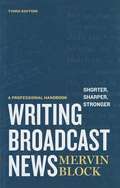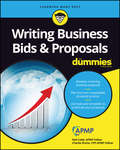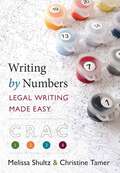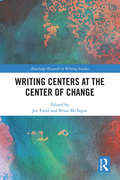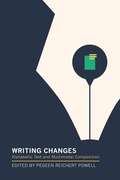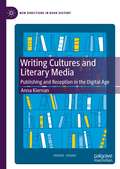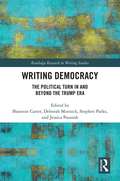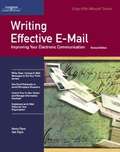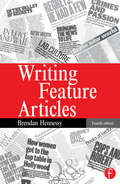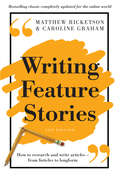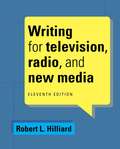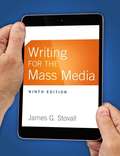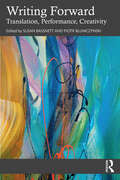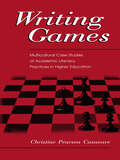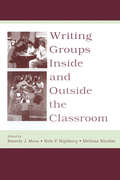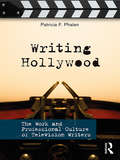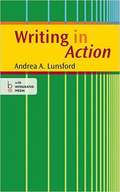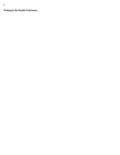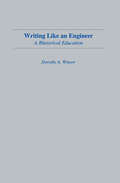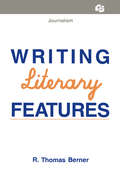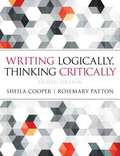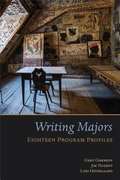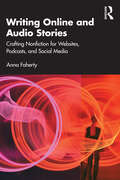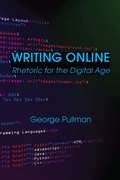- Table View
- List View
Writing Broadcast News: Shorter, Sharper, Stronger
by Mervin BlockMervin Block- who has written for the best in the business- offers timeless advice, guiding both first-year students and seasoned professionals through the essentials of writing for the ear. With countless scripts collected from writing workshops in newsrooms across the country, this resource is studded with insightful- and at times entertaining- comments, suggestions and much-needed corrections. Readers will find Block's clear and incisive voice coming through in the expanded "Top Tips of the Trade" and the "Dozen Deadly Sins"—reminding us that mistakes can be our best teachers. New "WordWatcher" boxes highlight the challenges in writing for print versus broadcast.
Writing Business Bids and Proposals For Dummies
by Neil Cobb Charlie DivineDevelop a winning business proposal Plan and use a repeatable proposal process Use tools and templates to accelerate your proposals Get the intel on bids and proposals Congratulations! You have in your hands the collected knowledge and skills of the professional proposal writer – without having to be one! Inside, you'll find out how to unlock what these professionals know and apply it to your own business to improve the way you capture new customers and communicate with existing ones! Inside... Develop a great proposal Focus on the customer Know your competition Plan your approach Use tools and templates Write persuasively Overcome misconceptions Expand your skills Avoid proposal killers
Writing By Numbers: Legal Writing Made Easy
by Melissa Shultz Christine TamerGiven the reality that legal writing is difficult for most new law students, Writing by Numbers: Legal Writing Made Easy aims to demystify the writing process by providing concrete formulas for mastering objective and persuasive legal writing. Put simply, at each juncture of your journey to become a proficient legal writer, this book gives you a roadmap to follow, broadly starting with the macro-formula CRAC (Conclusion, Rule, Analysis, and Conclusion) and then moving to micro-formulas for each part of the macro formula. The goal is that you will never find yourself lost―that is, you will never find yourself facing an entirely blank page without direction.
Writing Centers at the Center of Change (Routledge Research in Writing Studies)
by Joe Essid Brian McTagueWriting Centers at the Center of Change looks at how eleven centers, internationally, adapted to change at their institutions, during a decade when their very success has become a valued commodity in a larger struggle for resources on many campuses. Bringing together both US and international perspectives, this volume offers solutions for adapting to change in the world of writing centers, ranging from the logistical to the pedagogical, and even to the existential. Each author discusses the origins, appropriate responses, and partners to seek when change comes from within a school or outside it. Chapters document new programs being formed under changing circumstances, and suggest ways to navigate professional or pedagogical changes that may undermine the hard work of more than four decades of writing-center professionals. The book’s audience includes writing center and learning-commons administrators, university librarians, deans, department chairs affiliated with writing centers. It will also be useful for graduate students in composition, rhetoric, and academic writing.
Writing Changes: Alphabetic Text And Multimodal Composition
by Pegeen Reichert PowellWriting Changes moves beyond restrictive thinking about composition to examine writing as a material and social practice rich with contradictions. It analyzes the assumed dichotomy between writing and multimodal composition (which incorporates sounds, images, and gestures) as well as the truism that all texts are multimodal. Organized in four sections, the essays explore• alphabetic text and multimodal composition in writing studies• specific pedagogies that place writing in productive conversation with multimodal forms• current representations of writing and multimodality in textbooks, of instructors' attitudes toward social media, and of writing programs• ideas about writing studies as a discipline in the light of new communication practicesBookending the essays are an introduction that frames the collection and establishes key terms and concepts and an epilogue that both sums up and complicates the ideas in the essays.
Writing Cultures and Literary Media: Publishing and Reception in the Digital Age (New Directions in Book History)
by Anna KiernanThis Pivot investigates the impact of the digital on literary culture through the analysis of selected marketing narratives, social media stories, and reading communities. Drawing on the work of contemporary writers, from Bernardine Evaristo to Patricia Lockwood, each chapter addresses a specific tension arising from the overarching question: How has writing culture changed in this digital age? By examining shifting modes of literary production, this book considers how discourses of writing and publishing and hierarchies of cultural capital circulate in a socially motivated post-digital environment. Writing Cultures and Literary Media combines compelling accounts of book trends, reader reception, and interviews with writers and publishers to reveal fresh insights for students, practitioners, and scholars of writing, publishing, and communications.
Writing Democracy: The Political Turn in and Beyond the Trump Era (Routledge Research in Writing Studies)
by Steve Parks Shannon Carter Deborah Mutnick Jessica PauszekWriting Democracy: The Political Turn in and Beyond the Trump Era calls on the field of writing studies to take up a necessary agenda of social and economic change in its classrooms, its scholarship, and its communities to challenge the rise of neoliberalism and right-wing nationalism. Grown out of an extended national dialogue among public intellectuals, academic scholars, and writing teachers, collectively known as the Writing Democracy project, the book creates a strategic roadmap for how to reclaim the progressive and political possibilities of our field in response to the "twilight of neoliberalism" (Cox and Nilsen), ascendant right-wing nationalism at home (Trump) and abroad (Le Pen, Golden Dawn, UKIP), and hopeful radical uprisings (Black Lives Matter, Occupy Wall Street, Arab Spring). As such, the book tracks the emergence of a renewed left wing in rhetoric and activism post-2008, suggests how our work as teachers, scholars, and administrators can bring this new progressive framework into our institutions, and then moves outward to our role in activist campaigns that are reshaping public debate. Part history, part theory, this book will be an essential read for faculty, graduate students, and advanced undergraduate students in composition and rhetoric and related fields focused on progressive pedagogy, university-community partnerships, and politics.
Writing Effective E-Mail: Improving Your Electronic Communication
by Nancy Flynn Tom FlynnThe revised edition of Writing Effective E-Mail includes an added emphasis on how to avoid workplace disasters such as lost sales, customer service nightmares--and in the worst cases--lawsuits and financial losses, triggered by careless or poorly written e-mails. This book will also guide you in writing a comprehensive and effective e-mail policy for your organization.
Writing Feature Articles
by Brendan HennessyHennessy's classic text tells you everything you need to know about writing successful features. You will learn how to formulate and develop ideas and how to shape them to fit different markets. Now in its fourth edition, Writing Feature Articles has been fully revised and updated to take into account the changing requirements of journalism and media courses. You will also discover how to exploit new technology for both researching and writing online.Learn step-by-step how to plan, research and write articles for a wide variety of 'popular', 'quality' and specialist publications. Discover more and make the advice stick by completing the tasks and reading the keen analysis of extracts from the best of today's writing.Packed with inspirational advice in a friendly, highly readable style, this guide is a must-have for practising and aspiring journalists and writers.
Writing Feature Stories: How to research and write articles - from listicles to longform
by Caroline Graham Matthew RicketsonGood writing engages as it informs and feature journalism offers writers the opportunity to tell deep, affecting stories that look beyond the immediate mechanics of who, what, where and when and explore the more difficult-and more rewarding- questions: how and why? Whether you're a blogger, a news journalist or an aspiring lifestyle reporter, a strong voice and a fresh, informed perspective remain in short supply and strong demand; this book will help you craft the kind of narratives people can't wait to share on their social media feeds.Writing Feature Stories established a reputation as a comprehensive, thought-provoking and engaging introduction to researching and writing feature stories. This second edition is completely overhauled to reflect the range of print and digital feature formats, and the variety of online, mobile and traditional media in which they appear.This hands-on guide explains how to generate fresh ideas; research online and offline; make the most of interviews; sift and sort raw material; structure and write the story; edit and proofread your work; find the best platform for your story; and pitch your work to editors.'A wide-ranging, much-needed master class for anyone who tells true yarns in this fast-changing journalistic marketplace' - Bruce Shapiro, Columbia University'Useful and thought provoking' - Margaret Simons, journalist and author'A must read for any digital storyteller who wants to write emotive, engaging, believable content.' - Nidhi Dutt, foreign correspondent
Writing For Television, Radio, And New Media
by Robert L. HilliardYou can trust Hilliard's WRITING FOR TELEVISION, RADIO, AND NEW MEDIA to provide you with thorough and up-to-date coverage of the principles, techniques, and approaches of writing for television, radio, and the Internet. You'll learn about writing for a variety of formats, such as commercials, news and sports, documentaries, reality programs, talk shows, interviews, music programs, and drama and sitcoms. The book's comprehensive content, excellent organization, attention to form, and good examples ensure that you will be well trained for a career in the field.
Writing For The Mass Media (Ninth Edition)
by James G. StovallA clear and effective introduction to media writing Writing for the Mass Media offers clear writing, simple organization, abundant exercises, and precise examples that give students information about media writing and opportunities to develop their skills as professional writers. With a focus on a converged style of media writing, and converting that style into real work, this ninth edition maintains its classic and effective text/workbook format while staying ahead of the curve and preparing students for their future careers. MyCommunicationLab is an integral part of the Stovall program. MediaShare allows students to post speeches and share them with classmates and instructors. Interactive videos provide students with the opportunity to watch and evaluate sample speeches. Online self-assessments and pre- and post-tests help students assess their comfort level with public speaking and their knowledge of the material.
Writing For a Good Cause
by Joseph Barbato Danielle FurlichFilled with tips and survival skills from writers and fund-raising officers at nonprofits of all sizes, Writing for a Good Cause is the first book to explain how to use words well to win your cause the money it needs. Whether you work for a storefront social action agency or a leading university, the authors' knowledgeable, practical advice will help you: Write the perfect proposal -- from the initial research and interviews to the final product Draft, revise, and polish a "beguiling, exciting, can't-put-it-down and surely can't-turn-it-down" request for funds Create case statements and other big money materials -- also write, design, and print newsletters, and use the World Wide Web effectively Survive last-minute proposals and other crises -- with the Down-and-Dirty Proposal Kit! Writing for a Good Cause provides everything fund raisers, volunteers, staff writers, freelancers, and program directors need to know to win funds from individual, foundation, and corporate donors.
Writing Forward: Translation, Performance, Creativity
by Susan BassnettThis collection of essays by a team of internationally respected researchers at the cutting edge of translation studies was inspired by the idea of “writing forward” as a strategy for theatre translation proposed by David Johnston, the award-winning translator and scholar.Opening this volume is a conversation between David Johnston and Lawrence Venuti in which they explore a broad range of topics that bear on the translation of theatrical texts for performance. The chapters that follow are grouped into three main parts. Part I, “Extending translation”, contains essays whose respective theoretical emphases test, push, and stretch traditional conceptual boundaries. Part II, “Translating for theatre”, zooms in on various aspects of theatre translation. Part III, “Translation and creativity”, shifts the focus beyond the stage to other forms of artistic expression: poetry, painting, film, and television. Finally, in the short play Noli me tangere, written especially for this volume, Juan Mayorga reflects on theatre as the art of distance and on the mysteriousness of translation as the art of negotiating that distance.Thinking about and practicing translation as “writing forward” underscores its perpetual provisionality and hermeneutic openness; its ability to surprise and stimulate but also remind and reassure. By enriching our understanding of translation, performance, and creativity, this volume will no doubt inspire further explorations into their fascinating complexities. Useful and important reading for advanced students and researchers of literature, theatre, culture, and translation.
Writing Games: Multicultural Case Studies of Academic Literacy Practices in Higher Education
by Christine Pears CasanaveThis book explores how writers from several different cultures learn to write in their academic settings, and how their writing practices interact with and contribute to their evolving identities as students and professionals in academic environments in higher education. Embedded in a theoretical framework of situated practice, the naturalistic case studies and literacy autobiographies include portrayals of undergraduate students and teachers, master's level students, doctoral students, young bilingual faculty, and established scholars, all of whom are struggling to understand their roles in ambiguously defined communities of academic writers. In addition to the notion of situated practice, the other powerful concept used as an interpretive framework is captured by the metaphor of "games"--a metaphor designed to emphasize that the practice of academic writing is shaped but not dictated by rules and conventions; that writing games consist of the practice of playing, not the rules themselves; and that writers have choices about whether and how to play. Focusing on people rather than experiments, numbers, and abstractions, this interdisciplinary work draws on concepts and methods from narrative inquiry, qualitative anthropology and sociology, and case studies of academic literacy in the field of composition and rhetoric. The style of the book is accessible and reader friendly, eschewing highly technical insider language without dismissing complex issues. It has a multicultural focus in the sense that the people portrayed are from a number of different cultures within and outside North America. It is also a multivocal work: the author positions herself as both an insider and outsider and takes on the different voices of each; other voices that appear are those of her case study participants, and published authors and their case study participants. It is the author's hope that readers will find multiple ways to connect their own experiences with those of the writers the book portrays.
Writing Groups Inside and Outside the Classroom (International Writing Centers Association (IWCA) Press Series)
by Beverly J. Moss Nels P. Highberg Melissa NicolasThis unique collection considers the nature of writing groups inside and outside the academic environment. Exploring writing groups as contextual literacy events, editors Beverly J. Moss, Nels P. Highberg, and Melissa Nicolas bring together contributors to document and reflect on the various types of collaborations that occur in writing groups in a wide range of settings, both within and outside the academy. The chapters in this volume respond to a variety of questions about writing groups, including: *What is the impact of gender, race, and socioeconomic class on power dynamics in writing groups? *When is a writing group a community and are all writing groups communities? *How does the local community of a writing group impact the participation of group members in other local or global communities? *How does the local community of a writing group impact the participation of group members in other local or global communities? *What actions contribute to a strong community of writers and what actions contribute to the breakdown of community? *When and for whom are writing groups ineffective? *What is it about belonging to a community of writers that makes writing groups appealing to so many within and beyond the academy?Each chapter highlights how writing groups, whether or not they are labeled as such, function in various spaces and locations, and how collaboration works when writers from a variety of backgrounds with diverse interests come together. Writing Groups Inside and Outside the Classroom illustrates that writing groups outside of the academy are worthy of study and serve as important sites of writing and literacy instruction. Offering significant insights into the roles of writing groups in literacy and writing practice, this volume is appropriate for scholars and teachers of writing, rhetoric, composition, and literacy; for writing center administrators and staff; and for writing group participants.
Writing Hollywood: The Work and Professional Culture of Television Writers
by Patricia F. PhalenWriting Hollywood highlights the writing process in the production of television drama and comedy series in the U.S. The way writers do their jobs is heavily dependent not only on the demands of commercial business, but also on the uncertainties inherent in a writing career in Hollywood. Drawing on literature in the fields of Media Industry Studies and Occupational Culture, Writing Hollywood explains writers’ efforts to control risk and survive in a constantly changing environment. Using data from personal interviews and a six-week participant observation at a prime time drama, Dr. Phalen analyzes the relationships among writers in series television, describes the interactions between writers and studio/network executives, and explains how endogenous and exogenous pressures affect the occupational culture of the television writing profession.
Writing In Action
by Andrea A. LunsfordAndrea Lunsford’s research treats student writers as writers first—not only in the classroom, but in every aspect of their lives. Her newest handbook features a simple and inviting design that helps students find solutions for every situation as they translate their skills as writers in their day-to-day lives to the conventions of solid academic writing. Featuring the writing process coverage of larger handbooks at a value price, Writing in Action is a supportive reference that emphasizes rhetorical strategies that help students put their ideas into action.
Writing In The Health Professions
by Stuart Brown Barbara HeifferonPractical, applied, and up-to-the-minute, Writing for the Health Professions teaches students, healthcare professionals, and professional writers the essential skills in medical and health communications. Drawing on her extensive experience as a nurse, cardio-pulmonary technician, medical writer, and writing teacher, Barbara Heifferon addresses the communications requirements of the healthcare professions and those who write in these high-tech fields. This comprehensive text covers writing situations and documents common in hospitals, clinics, HMOs, health insurance companies, public health campaigns, and other healthcare environments. Special attention is given to visual and electronic forms of communication, including web sites and multimedia productions.
Writing Like An Engineer: A Rhetorical Education (Rhetoric, Knowledge, and Society Series)
by Dorothy A. WinsorComprised of a study spanning over five years, this text looks at four engineering co-op students as they write at work. Since the contributors have a foot in both worlds -- work and school -- the book should appeal to people who are interested in how students learn to write as well as people who are interested in what writing at work is like. Primarily concerned with whether engineers see their writing as rhetorical or persuasive, the study attempts to describe the students' changing understanding of what it is they do when they write. Two features of engineering practice that have particular impact on the extent to which engineers recognize persuasion are identified: * a reverence for data, and * the hierarchical structure of the organizations in which engineering is most commonly done. Both of these features discourage an open recognition of persuasion. Finally, the study shows that the four co-op students learned most of what they knew about writing at work by engaging in situated practice in the workplace, rather than by attending formal classes.
Writing Literary Features (Routledge Communication Series)
by R. Thomas BernerFirst Published in 1988. Routledge is an imprint of Taylor & Francis, an informa company.
Writing Logically, Thinking Critically
by Sheila Cooper Rosemary PattonThis concise, accessible text teaches students how to write logical, cohesive arguments and how to evaluate the arguments of others. Integrating writing skills with critical thinking skills, this practical book teaches students to draw logical inferences, identify premises and conclusions and use language precisely. Students also learn how to identify fallacies and to distinguish between inductive and deductive reasoning. Ideal for any composition class that emphasizes argument, this text includes coverage of writing style and rhetoric, logic, literature, research and documentation.
Writing Majors
by Lori Ostergaard Greg Giberson Jim NugentThe writing major is among the most exciting scenes in the evolving American university. Writing Majors is a collection of firsthand descriptions of the origins, growth, and transformations of eighteen different programs. The chapters provide useful administrative insight, benchmark information, and even inspiration for new curricular configurations from a range of institutions.A practical sourcebook for those who are building, revising, or administering their own writing majors, this volume also serves as a historical archive of a particular instance of growth and transformation in American higher education. Revealing bureaucratic, practical, and institutional matters as well as academic ideals and ideologies, each profile includes sections providing a detailed program review and rationale, an implementation narrative, and reflection and prospection about the program.Documenting eighteen stories of writing major programs in various stages of formation, preservation, and reform and exposing the contingencies of their local and material constitution, Writing Majors speaks as much to the "how to" of building writing major programs as to the larger "what," "why," and "how" of institutional growth and change.
Writing Online and Audio Stories: Crafting Nonfiction for Websites, Podcasts, and Social Media
by Anna FahertyGuiding readers through the unique challenges and choices presented by digital publication, this book provides a practical set of tools to help students, creatives, and content professionals craft emotionally engaging nonfiction stories for online readers and listeners. From considering what story to tell, to bringing narratives to life in practice, Anna Faherty explains what gives stories their unique power and demonstrates how to successfully combine techniques from short-stories and screenwriting with journalistic practices like fact checking and verification. Examples from corporate websites, personal blogs, podcasts, and social media set out how to attract and involve readers and listeners, and how to prompt them to take action. Readers will come away with a straightforward framework for planning and crafting storytelling projects and an understanding of text and script development, copyright, and editing. Each chapter includes summaries of key principles and practical writing tips, while case studies share insights from writers’ professional practices – including those who use storytelling to influence customers or advocate for change. Writing Online and Audio Stories is a valuable entry-point for creative writers, podcasters, and professionals in PR and marketing, as well as students undertaking courses such as Digital Writing, Creative Nonfiction and Multimedia Storytelling.
Writing Online: Rhetoric for the Digital Age
by George Pullman"Contrary to the old adage about finding new names for old things, Writing Online: Rhetoric for the Digital Age gives new life and new meaning to old names. The book and its companion website transform ancient rhetoric as a process of oral composition--invention, arrangement, memory, style, and delivery--into a digital rhetoric, a dynamic process of writing for the World Wide Web: dynamic because it shows not only how to write in a Web-based medium but, more importantly, how to learn and adapt to a medium that is constantly evolving and changing. Unlike conventional books that provide specific solutions to specific problems, Writing Online reenacts the process of solving Web-based writing problems, explaining everything from how to create a simple web page to how to develop a sophisticated content management system and everything in between: HTML, HTML5, CSS, JavaScript, PHP, and much more. As a digital rhetoric, moreover, Writing Online recreates the ancient processes of oral composition for a digital era. Digital invention becomes a push-pull process of transmitting information via searches, alerts, news aggregators, and read-write algorithms. Digital arrangement becomes a question-and-answer process inviting multiple responses via intuitive navigation systems and dynamic patterns of organization. Digital memory transforms the ancient memory palace into a dynamic, programmable content management system. Digital style provides computer-based tools to enhance writers' word choice, argumentative structures, and feedback. Digital delivery resituates speakers and writers in onscreen environments that balance functionality and aesthetics for optimum responsiveness and usability." --James P. Zappen, Professor, Department of Communication and Media, Rensselaer Polytechnic Institute
